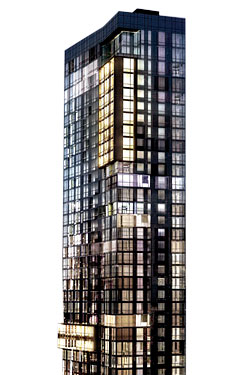
Donald Trump at his Trumpiest embodies a defiantly tasteless brand of glamour that New Yorkers are free to detest but can’t really disown. From the original Trump Tower to retro-steroidal Trump Place along Riverside Boulevard to the renovation of Wollman Rink and the beach-bronzed façade of Trump International Hotel & Tower at Columbus Circle, the master of gilt, black glass, and polychrome marble has proven that he gets New York, even if he’s looking at it with a rapacious eye.
But the newest venture to bear the baronial brand, the Trump SoHo hotel, looms over the corner of Varick and Spring Streets in a state of deadpan puzzlement, as if wondering how it got there: This is Soho? Sure, if you climb high enough in the 46-story tower you can get a Google Earth view of the neighborhood laced with industrial-chic boutiques. Or you can let your eye glide gently down the Hudson River toward the harbor. But at lower altitudes, the view to the south and west narrows to the traffic-clogged maw of the Holland Tunnel, with a parking lot in the foreground.
Handel Architects, which designed the hotel, dealt with this unpromising site by retreating from it. The main entrance turns away from the particulate-rich atmosphere of Varick Street and onto the relative tranquility of Spring. The base of the tower is ringed by a two-story block of fritted glass that hovers above the sidewalk, buffering the guest suites from the city. Inside, a David Rockwell cornucopia of walnut paneling and aubergine calfskin settees tries to attenuate the suspicion that this building doesn’t really want to be here. It’s tall, but it lacks its namesake’s swagger.
A great hotel—and Trump SoHo aspires to be nothing less—reflects an essence of its place. By the time guests have checked in, the hotel should already have enraptured them in an intense and specific feeling of “hereness.” When the Mandarin Oriental opened in the upper reaches of the Time Warner Center in 2003, it captured a distinctly New York obsession with preposterous extravagance, high-altitude vistas, and the titillation of inhabiting a glass box in the sky. Trump was once a master of such Zeitgeist theatrics, and in typical hyperbolic style, he has used his Soho outpost to erect the area’s tallest, costliest, and glassiest structure.
As with so much recent construction around New York, Trump SoHo’s size and transparency are only the most visible elements of a building with a fundamental problem: It could be almost anywhere, blankly reflecting anything. Instead of feeding on the raw commercial flavor of Soho’s western edge, the tower tries to inoculate the neighborhood with anodyne luxe. Instead of channeling Manhattan’s thrum, it offers one more victory for indoor indolence: a TV remote that allows guests to manage drapes, lights, and air conditioning without budging from bed.
When Trump went public with his proposal, neighborhood activists argued that the hotel’s height would alter the character of West Soho. But the finished building hardly seems to have any contact with the city at all—it just floats in front of its backdrop like a ham-fisted Photoshop job. The same cut-and-paste approach has sprinkled New York with buildings that can’t answer the most basic architectural question: What are you doing here? It’s a question that shouldn’t flummox a Trump.
Have good intel? Send tips to intel@nymag.com.
